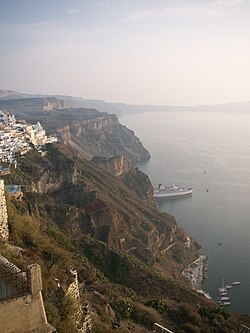Santorini caldera
Santorini caldera is a large, mostly submerged caldera. It is in Greece, in the southern Aegean Sea, 120 kilometers north of Crete. Visible above water is the circular Santorini island group.
 Santorini island group from space | |
| Location | |
|---|---|
| Location | Aegean Sea, Greece |
| Geology | |
| Type | Caldera (active) |
| Last eruption | 1950 |
The caldera measures about 12 by 7 km (7.5 by 4.3 mi), with 300 m (980 ft) high steep cliffs on three sides. There are two small volcanic islands at the center of the caldera, Nea ("New") Kameni and Palea ("Old") Kameni. The main island, Santorini has an area of 75.8 km2 (29.3 sq mi) km2.
The extraordinary beauty of Santorini's high walls, draped by whitewashed villages, combined with a sunny climate and clear air, have made it a magnet for tourists and volcanologists.[1]
Geology
The volcanic complex of Santorini is the most active part of the South Aegean Volcanic Arc. This marks the subduction of the African tectonic plate underneath the Aegean part of the Eurasian tectonic plate, at a rate of up to 5 cm per year in a northeasterly direction. It has earthquakes at depths of 150–170 km.[2]
Non-volcanic rocks are exposed on Santorini at the Profitis Ilias Mountain, Mesa Vouno, the Gavrillos ridge, Pirgos, Monolithos and the inner side of the caldera wall between Cape Plaka and Athinios.[3]
The Kameni islands at the center of the caldera are made of lava rocks.
Volcanology
The caldera is composed of overlapping shield volcanoes, cut by at least four partially overlapping calderas, of which the oldest southern caldera was formed about 180,000 years ago. The subsequent Skaros caldera was created about 70,000 years ago, and the Cape Riva caldera about 21,000 years ago. The current caldera was formed about 3600 years ago during the Minoan eruption.[4]
Palea Kameni and Nea Kameni were formed as a result of multiple, initially submarine eruptions at the center of the caldera.[5]
Although dormant, Santorini is an active volcano. Numerous minor and medium-sized, mainly effusive eruptions have built the dark-colored lava shields of Nea and Palea Kameni inside the caldera.
Their last eruption was in 1950, and now only smoke and gases come out.[1] GPS instruments have registered renewed deformation around the caldera in 2011 and 2012.[6]
The huge Minoan eruption of Santorini in the 17th century BC may have inspired the legend of Atlantis.[7] It was rated 7, the highest score for a historical eruption, in the Smithsonian Global Volcanism Program's Volcanic Explosivity Index.[8]
References
- ↑ 1.0 1.1 "Introduction - Santorini Volcano". Retrieved 2011-04-19.
- ↑ "Tectonic setting of Santorini". Retrieved 2011-04-20.
- ↑ "Geology of Santorini - The prevolcanic basement". Retrieved 2011-04-20.
- ↑ "Santorini summary". Smithsonian Global Volcanism Program. Archived from the original on 2013-12-24. Retrieved 2011-04-19.
- ↑ "Santorini volcanic caldera, Greece". Retrieved 2011-04-19.
- ↑ MSNBC "Volcano on scenic Greek island getting a little restless 3 March 2012
- ↑ Sparks, R. S. J. (2000). "Friedrich W.L. 2000. Fire in the sea: the Santorini volcano: natural history and the legend of Atlantis". Geological Magazine. Cambridge University Press. 137 (5): 593–594. doi:10.1017/S0016756800214611. S2CID 130034644.
- ↑ "Large volcano explocivity index". Countries of the World. Retrieved 2011-03-29.


